Visit your favourite destinations |
| A Report from birdtours.co.uk |
Report of a birding trip to South Africa, 17th Nov -20th Dec 02,
Moira and Graeme Wallace, Edinburgh, Scotland. dacnis@mwallace.freeserve.co.uk

STRUCTURE AND HEADINGS OF THE TRIP REPORT
Some of Graemes other Photos can be viewed at www.worldbirder.com
Background and Summary of the Trip.
Introduction
Birding Highlights
Major Misses
Logistics
Car Hire
Currency
Books
Trip Reports
Tapes
Local Guides
Various Addresses, e-mail and Telephone Numbers
Background and summary of the trip.
Introduction
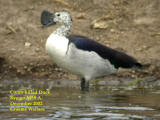 |
Comb-billed Duck |
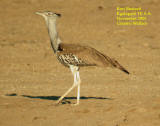 |
Kori Bustard |
In late September 2002 we heard from Clide Carter that places were still available on the Cape Pelagics trip to Prince Edward and Marion Islands and on to the Antarctic pack ice departing Cape Town on 1 November 2002. Once Graeme had secured a berth on the ship ( regrettably Moira is a poor sailor ) we decided to undertake a trip across South Africa encompassing all the major biomes; thus giving us the chance to see many of the southern Africa endemics.
The trip lasted some 35 days during which we drove almost 10,000 kilometres saw around 500 bird species, 44mammals and 4 reptiles. Birding in South Africa proved to be very relaxed, the birds numerous and highly accessible. Road infrastructure in general was excellent, although dirt roads were very dusty and a puncture hazard( we rented an extra spare tyre), but distances are immense. Accommodation, food and drink was of a very high standard and at the prevailing exchange rates offered excellent value. We encountered no problems on the trip and at no time did we feel at any risk.
Birding Highlights
The African Broadbill which performed brilliantly at the Oribi Gorge stake out, the tricky Kynsna Woodpecker taped out at Potberg, the day in the Kruger where in one day we saw African Finfoot, Pel's Fishing Owl, Pennant-winged, Freckled and Fiery-necked, Buff-spotted Flufftail in Underberg, Double-banded Courser at the last gasp at Merrick Game Farm, the myriad raptors of the Kgalagadi TP including Bateleur, Martial, Black-breasted and Brown Snake Eagle, Lappet-faced Vulture, Red-necked Falcon and the diminutive Pygmy Falcon, Cape Parrot at the nest at Benvie Farm, the elegant and endangered Blue Swallow at Underberg, the fantastic Southern Ground Hornbill at Kruger and the rare Taita Falcon that closed the list at the Strydom Tunnel are among the many highlights of a trip that saw us add new birds every day of our 34 day trip.
Major Misses
We did not try for Green Coucal or Delagorgue's Pigeon so among the species that we actually missed Green Twinspot really hurt as we invested a lot of time on it including returning from Mkuzi to St Lucia for a second unsuccessful try. Pink-throated Twinspot was also unaccountably missed at Mkuzi even with the best guide in the park. Other unfortunate dips were Southern-banded Snake Eagle at St Lucia, Cinnamon-breasted Warbler at Katbakkies and Aardvark Kloof, Cape Eagle Owl, Bronze-winged and Temminck's Courser.
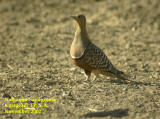 |
Namaqua Sandgrouse |
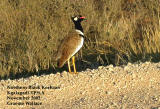 |
Northern Black Bustard |
Logistics
South Africa is a vast country but its excellent road infrastructure and accommodation options together with all the information available on the internet means that the logistics of a trip are relatively simple. If you plan to cover all of the major S.A. biomes in one trip the route will broadly follow Cape Town, Tanqua Karoo, Bushmanland/Namaqualand, Kgalagadi TP, Kimberley, Oribi Gorge, Underberg/Sani Pass, St Lucia, Mkuzi/Nsumo, Wakkerstroom, Kruger to Jo'burg. Depending upon personal preference and where you enter and exit the country there are many variations but there are really 2 principal options.
Option 1: Arrive in Jo'burg, fly to Kimberley, pick up a car and drive/bird to Cape Town. Fly Cape Town to Durban pick up a car and drive/bird to back to Jo'burg .
Option 2: Drive the whole way starting from Cape Town and finishing at Jo'burg ( or the reverse) paying the modest fee (200 Rand) charged when you elect to drop off the hire car thousands of miles from where it is picked up.
Car Hire
We elected to drive the entire route and rented a regular 2 wheel drive Toyota Tazz saloon which proved perfectly adequate on all roads. It cost us about £25 per day from Europcar. We did rent an extra spare tyre which we never needed but it's a comfort when you've already had one puncture and it's a further 200kms on a dirt road to the nearest garage. The only downside of using a "regular saloon" in the game parks is that you sit lower than for example if driving an RV and this, to a degree, can limit your field of view. It was most noticeable in the Kgalagadi TP where the effect was rather like driving on a winter road that has been snow ploughed except its sand on the road verges.
Although we did not know it some car rental companies do cheap deals on mobile phone rental and this seems to make a good deal of sense in a country where the nearest phone booth may be a long way off. Not sure of getting a signal in the middle of nowhere but a couple of birders who we spoke to said the phones were really useful.
Currency
At the time we visited in November/December 2002 the rand was exceptional value for us at R15/£1.
Site Information and Accommodation.
There is a wealth of information available on the internet and repeating it here would be redundant. This section is therefore limited to some very brief notes on sites that are not often mentioned and some subjective comments on other sites. The finalsection of the report provides some telephone numbers and e-mail addresses that might prove useful.
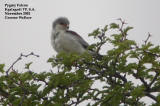 |
Pygmy Falcon |
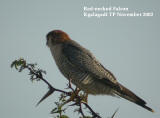 |
Red-necked Falcon |
Site Information
Strusbaii: An alternative site for Damara Tern which we saw easily. It is located on the coast, south of Breadasdorp on the road to Cape Agulhas.
Dassieshoek Nature Reserve: A small reserve north of the town of Robertson on the R60 where, on the advice of Claire Spottiswoode we looked for and found Protea Seedeater.
Tanqua Karoo:Look for the elusive Burchell's Courser along the P2250 leading from the R355 (Calvinia Road) to Tanqua Guest House. We saw the birds about 10kms along this road but they also occur on roads along the southern boundary of the Tanqua Karoo Park.
Oribi Gorge:An alternative site to Mkuzi for the tricky African Broadbill, in a gully on the left side of the road uphill from the car park at c Km 7.5, just beyond the Crowned Eagle nest.
Strydom Tunnel:The site for the rare Taita Falcon on the R36 as it crosses the Drakensberg Mountains.
Merrick Game Farm:This farm on the outskirts of Kimberley is possibly one of the best place to see Double-banded Courser. It's a commercial operation so make sure you call in advance.
Fig Forest Walk, Mkuzi:Ask for a guide called Tshablane (?). We went to the Fig Forest on 2 mornings and he was by far the best guide.
Kgalagadi TP: Just a fantastic place, particularly if you want to see raptors at close quarters. Accommodation was of a much higher standard than we had anticipated particularly at Twee Rivieren. Also the site for Leopard and Cheetah although these mammals still remain mythical as far as we are concerned!
Punda Maria Camp in the Kruger: Pel's Fishing Owl, and Pennant-winged Nightjar were being seen regularly when we were there and the guides seemed to have a real enthusiasm for their work This contrasted greatly with attitudes at Olifants which is supposedly the more regular site for Pels. The whole area from Punda Maria north to Pafuri and at the bridge over the Luvuvhu River was fantastic birding.
Books
Sasol Birds of Southern Africa 3rd edition. Sinclair, Hockey and Tarboton proved very useful.
Essential Birding in Western South Africa. Cohen & Spottiswoode ( ISBN 1-86872-524-3) is,as the name suggests, the essential guide to finding birds in this region. Short, to the point and well cross referenced it has clearly been written by people who know their birds and have spent along time in the field finding them. It is excellent.
Mammals of the National Parks. [ISBN 1-86825-726-6] one of many such guides available at all park shops proved quite adequate for mammal identification.
Kruger National Park Map. Purchased as we entered the park it proved to be most useful
Trip Reports
There is masses of useful information on the internet, from trip reports on the standard sites of which www.surfbirds.com and www.birdtours.co.uk are the best and for South Africa specifically, visit www.sabirding.co.za/birdspot which provides detailed information by site within region. Another useful source is www.parks-sa.co.za/tourism/birding which, as well as providing details of the birds of the national parks, provides a one stop shop for accommodation bookings and information an the camps.
Tapes
The standard for this is Guy Gibbons Southern African Bird Sounds which covers 900 species on 6 cassette tapes. Cost was R250.
Local Guides
For the Sani Pass Robin Guy (www.robguysani.co.za ) is the local expert and is, in addition, charming and engaging company. You could sort out the mandatory 4WD and do it yourself but Robin knows exactly where to find all the specialities in a day and has Buff-spotted Flufftail in his garden. Well worth it for Sani Pass and the grasslands but seemed less confident the following day in the forest at Donnybrook.
For birding around Wakkerstroom David Nkosi had been recommended, but was not available the day we needed him. Instead Norman Mncube (017 730 0023/082 584 1542) showed us around; he was very good and managed to find virtually all the specialties in one morning.
For Taita Falcon at the Strydom Tunnel you need to seek out Michael Khamako whose office is in an abandoned car near the tunnel. Just ask any of the ladies selling souvenirs at the roadside and you will eventually find him.
In the game parks we were not particularly impressed by the night drive guides who seemed largely to be going through the motions and were more interested in the mammals. The significant exception to this were the guides at Punda Maria in the Kruger where Ezekiel and ???? knew the special birds and where to find them. They were excellent.
Prior to and for a few days after the Antarctic trip we were the guests of Clide and Loretta Carter. To Loretta our thanks for her excellent hospitality and in general for putting up with us and to Clide for helping to get our South African trip off to such a good start. Particular thanks must also go to Claire Spottiswoode for the detailed "gen" she provided, the accommodation and excellent braii at Kimberley and for her enjoyable company. To another South African tour leader Malcolm Fair our appreciation for useful information he gave us in the Kgalagadi TP. (despite the prescence of paying customers!!) Thanks also to Chris Lodge whose company we greatly enjoyed for the first 10 days of the trip before his departure for the high life in Cape Town. Philip Rostron provided excellent, recent information on key species such as African Broadbill and Green Twinspot and we enjoyed looking for (and finding) Buff-spotted Flufftail with Frank Lambert whose amazingly accurate hand drawn site maps proved invaluable for Cape Parrot and Red-chested Flufftail. Grateful thanks to to Jeni Robertson the owner of Benvie Farm for allowing us to view the Cape Parrots and apologies also for waking her dogs at 04.30am!! Finally thanks to Steve Oosthuizen , a ranger in the Letaba Camp, who gave us great "gen" on Ground Hornbills and Barred Owl.
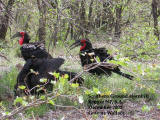 |
Southern Ground Hornbill |
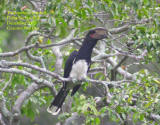 |
Trumpeter Hornbill |
30 October ( day 1)
Arrived Cape Town airport at 06.45 after busy but uneventful BA flight. Met by Clide Carter and joined by Chris Lodge who arrived on the Virgin flight at 07.30. Drove straight to Jankershoek NR and its fynbos vegetation near Stellenbosch for Protea Seed Eater which we missed. Still, lots of new birds. Then to Milnerton for White-backed Duck which we also missed before driving to Kommetjie, seeing all the cormorants and finally to Cape Point.
Mileage: 250km
Overnight: Simons Town
Bird Highlights; Cape Francolin, Black Cuckoo, Rameron Pigeon, Orange-breasted and Malachite Sunbird, Cape Sugarbird, Black Harrier, Cape Canary.
31October (Day 2)
Up at 04.00 to pick up Peter Kaestner who was looking for Cape Clapper Lark to add to the 7500+ birds already on his list. Spotted Eagle Owl on the road was a nice start. Arrived Milnerton at 05.45 to fail again with White-backed Duck and then on to the Darling Road Loop where the Clapper was soon found. Next the gypsum mine at Yzerfontein where Chestnut-banded Plover and a host of other waders were found. Then on to West Coast National Park where a large black snake was a foretaste of things to come. Lunch at Langebaan and a long drive, birding on the way, to the water/sewage works at Paarl which held a host of ducks before concluding the day with an African Penguin in the headlights at Simons Town.
Mileage: 400km
Overnight: Simons Town.
Highlights; Spotted Eagle Owl, Cape Clapper Lark, Orange-throated Longclaw, Southern Black Korhaan, African Crake, Black & Maccoa Duck, Spotted Thick Knee, Pin-tailed Whydah.
Mammals; Rock Dassie
1November - 17November.
Trip to Marion, Prince Edward Islands and the Antarctic Pack Ice.
18 November (Day 3)
Up at 04.30 for Constantia Greenbelts where we heard but could not tape in Knysna Warbler. Tried several different locations for 3 hours hearing several birds. Long drive around False Bay to Rooi Els where the Cape Rockjumper kept us waiting for an hour and a half; once found it proved most confiding. Then on to Harold Porter Botanical Gardens.
Mileage: 300km
Overnight: Simons Town.
Highlights; Forest Buzzard, Jackal Buzzard, Cape Rockjumper, Cape Sugarbird, Black Saw-wing, Cape Rock Thrush, Cape Siskin, Victorin's Warbler, Swee Waxbill.
Mammals; Southern Right Whale
19 November (Day 4)
Up at 04.30 and back to Constantia where, once again, we only heard the Knysna Warbler. Next, on to Tokai Forest which was quiet although perched Spotted Eagle Owl was good, female Chaffinch less so. At 10.00am bade farewell to Clide & Loretta Carter and left Simons Town for the long drive through the wheat lands to De Hoop NR with a short detour to Strusbaii for Damara Tern. Arrived De Hoop mid-afternoon to find it pretty quiet and the lake totally dried out. Birded round the HQ and campsite area and finally along the dirt road through the farmlands. Drove the back roads for an hour at night but saw nothing.
Mileage: 350 km
Overnight: Koppiehuise.
Bird Highlights; Spotted Eagle Owl, Forest Buzzard, Damara Tern, Blue Crane, Stanley's Bustard, Red-capped Lark, Agulhas Clapper Lark, Speckled Mousebird, Yellow Canary.
Mammals; Chacma Baboon, Cape Mountain Zebra, Bontebok,
20 November (Day 5)
High winds were worrying as we entered De Hoop at 07.00 but Aghulas Clapper Lark was an early success. However birding proved slow and we left the park to drive the few kms through farmland to Potberg. Cape Vulture soon showed;the endemic Knysna Woodpecker proved more difficult but we eventually taped one in for great views.
Mileage: 100km.
Overnight: Koppiehuise
Bird Highlights; Cape Vulture, Knysna Woodpecker, Thick-billed, Red-capped, Aghulas Clapper and Long-billed Lark, Blue Crane (73!)
Mammals; Bontebok
21 November (Day 6)
Departed Oulpaas 07.30, drove to Swellendam seeing the "usual" larks but 2 Karoo Korhaan in a stony field were something of a surprise. Tried a pond near Swellandam for White-backed Duck but failed again. Headed to Bontebok NP where we quickly found Pearl-breasted Swallow and a further surprise ( on an otherwise uneventful drive round Bontebok) was a small flock of Quail Finch which provided unexpectedly good views as they came in to drink at a small puddle. Then off to Robertson and Dassieshook Nature Reserve to try for the endemic and tricky Protea Seed-eater. Took us a while to find the NR but when we arrived a Protea showed immediately right in front of us and then promptly disappeared never to be seen again.
Mileage: 150km
Overnight; Grand Hotel in Robertson.
Bird Highlights; Karoo Korhaan, Quail Finch, Protea Seed-eater, Common Waxbill.
22 November (Day 7)
Bade farewell to Chris Lodge and headed off to the south-western corner of the Karoo, following the route set out in Essential Birding. Major road works slowed progress and did not reach the farmhouse at Karoopoort until 10.30. However, Namaqua Warbler showed well and we continued north to Eierkop stopping along the way. At the distinctive hill at Eierkop we looked unsuccessfully for the Karoo Eremomela before heading north again to Katbakkies to look for Cinnamon-breasted Warbler. Despite thrashing around the rocky slopes for 2-3 hours, we heard and saw nothing of the warbler. Drove north, turning on to the P2250 to Bo-Wadrif stopping between Km 8-12 to look for Burchell's Courser which we knew to be there. Brief but clear views of this difficult bird before heading for an overnight stay at the desert-like fort of the Tanqua Guesthouse. Despite missing a couple of birds we did manage to see most of the Karoo species.
Mileage: 330km
Overnight: Tanqua Guesthouse
Bird Highlights; Black Harrier, South African Shelduck, Pale-chanting Goshawk, Burchell's Courser, Fairy Flycatcher, Long-billed Crombec, Rufous-eared Warbler, Karoo and Red-capped Larks, Tractrac Chat, Pale-winged Starling.
23 November (Day 8)
On a chilly morning, a 05.15 departure in the hope of better views of Burchell's Courser which were not forthcoming but a stop at a water tank gave stellar views of Namaqua Sandgrouse, Grey-backed Finchlark and Black-headed Canary. Returned to the guesthouse for an excellent breakfast before making a huge mistake in taking an appalling and desolate back road off the farm before eventually re-joining the R355. Good views of a pair of Karoo Korhaan on the road to Calvinia where we discovered that we had a puncture. After changing the wheel we headed on to Kammieskroon where we found a pair of Ludwig's Bustards. Finally on to Gamoep eventually arriving at 19.00 at Dipvlei. Night drive after dinner for Aardark and Aardwolf proved disappointing.
Mileage: 550km
Overnight: Dipvlei Guest House.
Highlights; Namaqua Sandgrouse, Northern Black Korhaan, Ludwig's Bustard, Greater Kestrel,Thick-billed and Spike-keeled Lark, Cape Bunting.
Mammals; Striped Polecat.
24 November (Day 9)
Departed 05.15 on a freezing, windy morning to drive back to Aardvark Kloof, another site for Cinnamon-breasted Warbler. Returned to Dipvlei for breakfast at 10.30 and set off for Poffadder, stopping at the Koa Dunes for the localised dune form of Red Lark which sadly was not at home. We checked into the Poffadder Hotel around 14.30 by which time it was blazing hot so waited until 15.15 and then drove the back roads south of Poffadder.
Mileage: 300km
Overnight: Poffadder Hotel.
Highlights; Sabota Lark, Karoo Long-billed Lark, Yellow-bellied Eremomela, Layard's Titbabbler, Sociable Weaver, Black-headed Canary.
25 November (Day 10)
Out at 06.30 for a fast drive to the Koa Dunes, stopping unsuccessfully for Sclater's Lark on the way. After a fruitless 2 hours playing a tape and looking through countless Lark-like Buntings at the water troughs we were about to give up on Red Lark when one unmistakeable male suddenly appeared. Great views of this localised lark before returning to Pofadder for a late breakfast and an 11.00am departure. Tried and failed again for Sclater's Lark before embarking on the long drive to the Kgalagadi TP. Arrived at Twee Rivieren, checking in to their excellent lodge accommodation around 17.00 and went out on a night drive at 18.30 which produced some nice mammals as well as a calling Giant Eagle Owl framed against a full moon.
Mileage: 450km
Overnight Twee Rivieren Camp
Highlights; Red Lark, Kori Bustard, Giant Eagle Owl.
Mammal Highlights; Suricate ( Meercat ), African Wildcat, Honey Badger, Black-backed Jackal, Lesser-spotted Genet and 4 sleepy Lion, Cape Hare, Spring Hare .
26 November (Day 11)
Departed late for Nossob at 08.30 arriving at the Rooiputs waterhole around 09.30 where 6 Burchell's Sandgrouse gave great views - surprisingly, no Namaqua Sandgrouse. Drove steadily north stopping frequently for the many birds that lined the route. Raptors were particularly evident including an astonishing mixed group of 140+ vultures on the ground and perched low in the trees. Arrived at Nossob camp around 16.30 where we checked into our adequate but un-lockable chalet. At dusk, we took a walk around the camp finding 3 roosting White-faced Owl and Rufous-cheeked Nightjar responded to tape flying in to call from the ground about 3m away. It was a great day's birding.
Mileage: 160km
Overnight Nossob Camp.
Highlights; White-backed, Lappet-faced and Cape Vultures, Bateleur, Tawny, Martial and Wahlberg's Eagles, Black-breasted and Brown Snake Eagles, Red-headed Falcon, Giant Eagle Owl, White-faced Owl, Rufous-cheeked Nightjar and Swallow-tailed Bee-eater, Fawn-coloured Lark.
Mammals; Gemsbok, Springbok, Eland, Blue Wildebeest.
27 November (Day 12)
Departed 05.30 heading for the long drive towards Union's End but after a great day's birding yesterday, today proved a bit disappointing and we turned back after 75 km having seen only a few birds. Arrived back at Nossob around 14.00 and rested until 15.30 before taking a drive to Masa Se Draai but added little. Late in the afternoon birding around the camp produced a few new birds.
Mileage: 160km
Overnight Nossob Camp.
Highlights; Booted Eagle, Lanner and Red-necked Falcons, Gabar Goshawk, Shaft-tailed Wydah, Crimson-breasted Shrike (Gonolek), Red-faced Mousebird, Swallow-tailed Bee-eater.
Mammals; Red Hartebeest
28 November (Day 13)
Decided to drive back to Twee Riverien via the lower dune road that connects the Nossob with the Aoub river bed in the search for the missing Pink-billed Lark, Great Sparrow and Violet-eared Waxbill. After a slow first hour or two the day picked up with scope views of Yellow-billed Hornbill and the endemic Pygmy Falcon. Reached the picnic spot at Kaspersdraai but failed to find Great Sparrow. Whilst there bumped into Malcolm Fair, a South African bird guide who gave us some useful, recent gen on Pink-billed Lark on the second dune road and Violet-eared Waxbill at Melkvlei. Headed south where mobbing birds betrayed the presence of the delightful Pearl-spotted Owlet and on to the loop road to Melkvlei. Unfortunately, no waxbill but a magnificent but much too close Cape Cobra did provide some stimulation! Finally crossed on to the dune road where, after some difficulty, we eventually found 2 Pink-billed Lark.
Mileage:210km
Overnight: Twee Rivieren Camp
Highlights; Northern Black Korhaan Southern Yellow-billed Hornbill, Pygmy Falcon, Cardinal Woodpecker, Lilac-breasted Roller, Pearl-spotted Owlet , Pink-billed Lark, Red-headed Finch.
Mammals; Brown Hyena
29 November (Day 14)
The day of the first long drive from the Kgalagadi TP to Kimberley. Out early at 05.30 along the Aoub River for a last minute search for Red-crested Korhaan and Double-banded Courser. Failed with both but did see displaying Northern Black Korhaan and Eastern Clapper Lark. Left Twee Riverien around 09.00 and drove furiously to Kimberley arriving mid-afternoon. Salvation for Double-banded Courser was found in a visit to Marrick Game Farm on the outskirts of Kimberley where the owners kindly and at no charge allowed us to drive around their property. No time however to try for the localised Short-toed Rock Thrush and in the late afternoon we arrived at Benfontein Farm. Purchased by De Beers 40 years ago as part of a land grab just in case there were any diamonds underneath - there aren't - the farm was being used as a base for avian research by our host Claire Spottiswoode. Excellent braii in good company and delightful surroundings
Overnight Benfontein Farm
Mileage 800km
Highlights: Double-banded Courser, Eastern Clapper Lark.
30 November (Day 15)
We joined Claire and four friends who were doing a Big Birding Day setting out at 03.30. In the dark and pre-dawn light they had 35 birds on their list before we had seen one. Red-crested Korhaan showed well but the tricky Orange River Francolin proved elusive - the first dip in what was to be a frustrating morning. Departed the farm at 08.00, returning on our own to the outskirts of Kimberley and to the site for Short-toed Rock Thrush which for some reason was not at home; headed into Kimberley where we found Bradfield's Swift at The Big Hole. Then spent ages trying to find the site for Black-eared Waxbill which was eventually traced to the middle of an industrial estate - the scrubby land yielded nothing of any note except for a large sign saying Danger Cobra! Traffic jams in Kimberley delayed our departure before we embarked on another furious drive south-east around Lesotho skirting the mighty Drakensberg Mountains, eventually arriving late afternoon at Robin Guy's home in Underberg where Buff-spotted Flufftail was calling in the garden. Met up again with Frank Lambert and over dinner discussed the plans for birding Sani Pass the following day before spending a couple of hours crawling around the bushes in an unsuccessful search for the calling Flufftail.
Mileage: 800km
Overnight : Robin Guy's home in Underberg
Highlights; Red-crested Korhaan, Jacobin Cuckoo, Buffy Pipit, Bradfield's Swift. Long-tailed Widowbird.
01December ( Day 16)
Out at 06.00 heading for the Sani Pass where we spent most of the day driving up this winding road over the border into Lesotho before returning in the late afternoon to bird in the plains and grasslands around Underberg. Just before dusk we finally managed to track down the Buff-spotted Flufftail in Robin Guy's garden which eventually revealed itself to be in the bush that we had surrounded the previous night - we had great views of this elusive bird. Robin Guy proved to be an excellent guide giving us a great day's birding.
Mileage : 180kms ( in Robin's 4WD)
Overnight : Robin Guy's home in Underberg
Highlights: Southern Bald Ibis, Buff-spotted Flufftail, Wattled & Crowned Cranes, Horus Swift, Drakensberg Rockjumper, Ground Woodpecker, Sharp-billed Honeyguide, Bush Blackcap, Barratt's Warbler, Gurney's Sugarbird, White-throated Swallow, Eastern Red-footed Falcon.
02 December (Day 17)
Up at 05.15 for Cape Parrot and Orange Thrush at Donnybrook Forest. We heard the parrot fly over and obtained poor flight views of Orange Thrush. Robin Guy seemed less assured in the forest and the only bird of note was Knysna Turaco. The morning was later saved by great views of 6 of the elegant but endangered Blue Swallow. Although we had planned to stay the whole day, we determined to move on quickly north to Howick where Frank Lambert had kindly provided a detailed map of Cape Parrot nest. Left Underberg early afternoon and drove to Howick, checking in to the Howick Falls Hotel. Telephoned the owner of Benvie Farm, the site of the Cape Parrot nest, who kindly gave permission to enter the property early next morning. Back out late afternoon to check the route to Benvie Farm.
Mileage: 350km
Highlights: Knysna Turaco, Blue Swallow, Collared Sunbird.
03 December ( Day 18)
Departed Howick at 04.15 and arrived at Benvie Farm at 05.00. Orange Thrush and Emerald Cuckoo were calling but initially we failed to find them before focusing on the parrots which were scheduled to appear at 05.15. They were late, probably due to the misty conditions in the valley below where they are thought to roost, but they eventually flew in to feed the chick at 05.50 affording great scope views of this endangered endemic. Spent the next hour or so walking the forested gardens at Benvie seeing Orange Thrush on the ground at 1m, Starred & Chorister Robins and Puffback before returning to Howick for late breakfast. It had been a great morning. Visited Umgeni Nature Reserve just north of Howick where Frank Lambert had seen some good birds and we had heard that Cape Eagle Owl roosted in the gorge but regrettably, deteriorating weather limited our efforts.
Departed Howick early afternoon on what was to be the most disastrous 12 hours of the trip. Got totally lost in Pietermaritzburg and once out of town encountered a major traffic accident in thick fog which further delayed us. Torrential rain and a major detour made things even worse but eventually out of the darkness we saw the welcoming sign of the Weza-Ngele Lodge. Unbelievably, the place was completely closed for a private function and the security guards would not even let us go up to the house to phone for alternative accommodation. We then drove, still in torrential rain, to Harding where 3 B&Bs proved to be full before deciding to drive on to Oribi Gorge Hotel who fortunately were still open and able to give us a bed.
Mileage: 300km
Overnight: Oribi Gorge Hotel.
Highlights: Cape Parrot, Orange Thrush, Olive Thrush, Starred Robin,, Chorister Robin Chat, African Emerald Cuckoo (h), Rufous-necked Wryneck, Black-backed Puffback, Mountain Wagtail, Red-collared Widowbird.
04 December (Day 19)
Got up late, birded the hotel grounds and then spent the remainder of the day in Oribi Gorge, particularly around KM 7-8 where we saw a good variety of birds..
Mileage: 100km
Overnight: Oribi Gorge Hotel
Highlights; Crowned Eagle, Gymnogene, Narina Trogon, Trumpeter Hornbill, White-browed Coucal, Green Woodhoopoe, Crowned Hornbill, Olive Woodpecker, Lesser Honeyguide, African Paradise Flycatcher, White-bellied and Grey Sunbird, Square-tailed Drongo, Black Cuckooshrike.
05 December (Day 20)
Up at 05.30 for one of the key birds of the trip - African Broadbill, which performed magnificently at its Oribi Gorge Km 7 stakeout. Fantastic views of its bizarre branch spinning display flight. The dry morning gave way to soaking drizzle, heavy rain and low cloud so it was something of a hit or miss for the rest of the day. We spent a lot of time looking for the uncommon Spotted Thrush which we knew to be breeding there but couldn't find it.
Milege: 50km
Overnight: Oribi Gorge Hotel
Highlights; African Broadbill, Olive Sunbird, Black-collared Barbet, Natal Robin, Yellow-throated Woodland Warbler.
06 December (Day 21)
It poured with rain all night and was still lashing down at 05.30; tried again for Spotted Thrush but failed which rather set the pattern for the rest of the day. Left Oribi Gorge for St Lucia, driving to Durban in grey skies and pouring rain. Once through Durban the weather improved and we took a 45 minute detour at Mutzini in a fruitless search for the local Palmnut Vulture. On to St Lucia, checked in to the wonderful accommodation at Kingfisher Lodge and drove the 35km through St Lucia NP to Cape Vidal where Green Twinspot were the target in the casuarina trees around the timber chalets. Twinspots were not at home and neither was the other key bird, Southern Banded Snake Eagle. The day was brought to a dismal close when, just as we parked the car at the Natal Nightjar site, the heaven's opened and rained out any attempt that night.
Mileage: 500km.
Overnight: Kingfisher Lodge.
Highlights: African Fish-Eagle, Crested Guineafowl, Wood Owl, Brown-hooded Kingfisher, Blue-cheeked and Little Bee-eater.
07 December (Day 22)
Out at 04.45, drove straight to Cape Vidal to resume the search for Green Twinspot. Nothing was calling and walked for 2-3 hours around the cabins and up the Whale Trail, seeing nothing. Went back to Kingfisher Lodge mid-morning and walked the Igalagwala trail in the forest beside the lodge which produced some new birds. Returned to Cape Vidal but failed again with the Twinspot, we don't know if they were there but if so they remained extremely secretive. However, the day ended on a bright note with great views of Natal Nightjar which responded well to tape at the old airstrip just by the entrance gate to St Lucia NP and with African Wood Owl on the way back from dinner.
Mileage: 100km.
Overnight: Kingfisher Lodge.
Highlight; Natal Nightjar, Pink-backed Pelican, African Green Pigeon, White-eared Barbet, Livingstone's Turaco, Yellow-throated Longclaw, Ashy Flycatcher, Grey Waxbill.
Mammals; Nile Crocodile
08 December (Day 23)
Departed St Lucia early morning for the drive to Mkuzi NP. Short detour at Hluhluwe failed to produce Lemon-breasted Canary or indeed any canary. Arrived in Mkuzi early afternoon in very hot conditions. Bumped into Peter Sinclair and Peter Ryan on reconnaissance for their 24hr Birding World record the following day only to be told that they had heard Green Twinspot on the Igalagwala trail in St Lucia where we had been the previous day. Later in the afternoon, drove to Pan to get our bearings before returning to the Kubube and Kumasinga hides. Just before dusk, drove some way back towards the park gate to try for nightjars.
Mileage: 230km
Overnight: Tented Safari Camp
Highlights: African Openbill, Crested Francolin, Kittlitz's Plover, Collared Pratincole, Grey and Purple-crested Turaco, Black-collared Barbet, Mozambique Nightjar, Pygmy Kingfisher, Black-crowned Tchagra, Golden-breasted Bunting.
Mammals, Zebra, Giraffe and Hippopotamus.
09 December (Day 24)
Early morning at the Kumasinga hide, which was pretty quiet, except for a stunning Gorgeous Bush-shrike. Spent most of the day driving around the park seeing quite a number of birds but not much that was new except for good views of a Black-bellied Korhaan perched on a mound where we were to see him every day thereafter. Conditions were not good with a howling wind and we returned to Pan for more hippopotamus and a good variety of waterbirds. Booked the Fig Forest Walk for the following morning which must now be undertaken with an armed guide. Drove out again before dusk in search of nightjars, seeing some on the road which we couldn't identify as they were not calling.
Mileage: 70km
Overnight Tented Safari Camp
Highlights; Yellow-billed Stork, Marabou Stork, African Spoonbill, African Pygmy Goose, African Jacana, Lesser Spotted Eagle, Black-bellied Korhaan, Golden-tailed Woodpecker, White-throated Robin, Yellow & Spectacled Weavers, Gorgeous Bush-shrike, Southern Black Tit.
Mammals; Nile Crocodile, Hippopotamus, Waterbuck, Nyala, Impala
10 December (Day 25)
Howling wind through the night kept us awake and conditions not ideal for the Fig Forest. Went to reception where it appeared that we were to be 2 of 28 people for the Fig Forest Walk. Forunately however, 24 of the party realised that this was not what they wanted and headed off for a morning game walk. Drove to the Fig Forest where conditions made birding difficult but we had nice views of a number of species but not the Pink-throated Twinspot. We also harboured hopes of Pel's Fishing Owl but the river was virtually dry and we were told that the roosting owls which had been seen 3 weeks previously had probably moved on. Returning to the Park HQ we met ace guide Tshablane whom we booked for the following morning for the Fig Forest. He told us that Pink-throated Twinspot could be found around Cottage 6 and along the River Walk which we tried in the afternoon without success.
Mileage; 50km
Overnight: Tented Safari Camp
Highlights: Broad-billed Roller, Narina Trogon, Giant Eagle Owl, Scaly-throated Honeyguide, Chinspot Batis, Black-bellied Starling, Mariqua Sunbird, Spectacled and Yellow Weaver.
11 December (Day 26)
As day dawned, howling wind had given way to gentle drizzle and after the usual chaotic allocation of guides to customers, we finally set off with Tshablane for the Fig Forest. The guide was excellent and we saw a number of very good birds on the 2 hour walk. Based on the excellent morning, we booked Tshablane for the River Walk in the afternoon to try again for the Twinspot. In the event it was very hot and unfortunately we saw very little before the guide called it off after about 1 hour because nothing was moving. Drove back to Pan, returning to the Kumasinga hide in the late afternoon. That night we determined to return to St Lucia for one more try at the Green Twinspot.
Mileage: 60kms
Overnight: Tented Safari Camp
Highlights; African Broadbill, Wattled-eyed Flycatcher, Brown-headed Parrot, Golden-rumped and Red-fronted Tinker-Barbet, Crested Barbet, Woodland Kingfisher, Hamerkop, Yellow-spotted Nicator, White-browed Robin, ,Blue-mantled Crested Flycatcher, Fan-tailed Flycatcher White Helmet-shrike, Wattled Starling.
12 December (Day 27)
Attempted to do the same walk on our own as we had followed with Tshablane the previous day but were prevented from doing so by the staff at a checkpoint half-way round. Went back to camp and tidied up taking care to avoid the long green mamba that had taken over our kitchen area. Headed for St Lucia, diverting for Lemon-breasted Canary at Hluhluwe which again was not at home. Arrived late afternoon at the Kingfisher Lodge and walked Sugar Loaf Park and the Igwalagala Trail where Twinspot has been seen but encountered little except for the sound of calling Buff-spotted Flufftail.
Mileage: 150km
Overnight: Kingfisher Lodge
Mammals; Nile Crocodile.
13 December (Day 28)
As the date suggests, this turned into something of a black Friday. Up at 4.30 , we arrived at Cape Vidal at 5.30 and spent 3 hours looking for, but failing to find, Green Twinspot. Finally we gave up, returned to Kingfisher Lodge and checked out for the drive to Wakkerstroom. The drive was uneventful and we arrived in the one-horse town eager to check into the Beautiful Just B& B run by John McAllister. Despite having booked, we arrived to find the place locked. John's neighbours very kindly gave us coffee and biscuits and called John's wife who finally turned up 2 hours later viewing us with some indifference, claiming that we didn't have a booking (which we did) and that the place was full with another party who appeared to have precedence. She booked us into the Weaver's Nest where we settled in to a nice chalet. However the chalet appeared to have no electricity and when we enquired the reason for this, inexplicably, the owner flew off the handle and told us to get off her property. We retreated to the chalet and wandered down for dinner to find the owner somewhat calmer. Eventually we had a delightful stay.
Mileage: 350km
Overnight: Weavers Nest Hotel
Highlights: Red-backed Mannikin, Diederik Cuckoo, Orange-breasted Waxbill, Scarlet-chested Sunbird, Purple-banded Sunbird.
14 December (Day 29)
Up at 4.30 to meet our guide, Norman MnCube and spent the morning searching, and in large measure finding, all the local specialities with only the localised version of White-bellied Korhaan proving elusive. Went out in the afternoon to look again for the Korhaan before returning to the marsh early evening to look for Red-chested Flufftail and Marsh Owl, the latter gave great views but no sign of the Flufftail. That evening John McAllister courteously called to apologise for their double booking.
Mileage: 250km
Overnight: Weavers Nest Hotel
Highlights: Blue-breasted Korhaan, Swainson's Francolin, Rudd's & Botha's Larks, Ayers Cisticola, African Marsh Owl, Yellow-breasted Pipit, Montagu's Harrier, Black Sparrowhawk, Black Widowfinch.
15 December (Day 30)
Went to the marsh early morning where Red-chested Flufftail was calling but never got closer than hearing it. Checked out of the Weavers Nest for the long drive to Kruger NP. Arrived mid afternoon to discover that the speed limit in the park was 50km per hour thus making it touch and go as to whether we would reach Orpen camp in time for the night drive. In the event, not only did we miss the night drive we were also booked( quite properly) for speeding and threatened with being thrown out of the park if we further transgressed. This camp was the most basic of the 4 we were to stay at in Kruger and while the accommodation was adequate the communal kitchen facilities were completely inadequate.
Mileage: 560km
Overnight: Orpen Camp
Highlights; Arrow-marked Babbler
Mammals; African Elephant, Giraffe, Waterbuck, Burchell's Zebra, Warthog
16 December (Day 31)
Departed Orpen at dawn for the long and extremely tedious drive to Punda Maria. The density of birds was only a fraction of that which we had experienced in the Kgalagadi TP and very little birdlife could be seen from the road. Stopped off at Letaba for breakfast seeing Groundscraper Thrush. However, on the mammal front, Black Rhino, one male and three female lions were nice to see. On arrival at Punda Maria we were greatly encouraged that both Pennant-winged Nightjar and Pel's Fishing Owl had been seen the previous day. Immediately booked up for the night drive and a morning walk for the following day before heading out to bird around the area. Returned for the night drive departing at 17.00. Our guide Ezekiel seemed confident about the nightjar and the early omens were good with Giant Eagle Owl and a massive herd of Water Buffalo. However, the skies darkened, the wind began to howl and a storm of biblical proportions broke over us. Lightning ripped through the sky and torrential rain soon turned to stinging hail as we abandoned the drive and headed back to the camp occasionally having to stop and get out to clear fallen branches blocking the road. Absolutely soaked and freezing cold we got back to the camp where the storm promptly passed on.
Mileage: 300km
Overnight: Punda Maria Camp
Highlights: Giant Eagle Owl, Groundscraper Thrush, Senegal Lapwings.
Mammals; Square-lipped {White} Rhinoceros, Nyala, Kudu,,Buffalo
17 December (Day 31)
Up at 03.30 for a 04.00 departure for the morning walk along the banks of the Luvuvhu River which was at a very low ebb as a result of the recent drought. To our great surprise the first bird we saw on the river was a pair of African Finfoot which set the tone for what was to become a great day. Walked the riverbank and rescued a newly hatched crocodile which was too weak to make it to the river - the guide gave it a helping hand which it did not seem to entirely appreciate, once in the water however it seemed happier and swam off. We could now see patches of riverine forest ahead of us which we entered with great expectation as this was the site for the fabulous Pel's Owl. On this occasion, luck was with us and we had stellar views of this huge, marmalade owl. It was perched high in one of the great riverine trees but flapped off just as we got on to it. However it did not go far and we were able to enjoy great perched views. After a late breakfast, we drove from Punda Maria north via the Klopperfontein loop to the bridge over the Luvuvhu River near Pafuri which all proved very productive. Returned late afternoon for the night drive which this time took place in fine weather. Several female Pennant-winged Nightjar were seen before a stunning male flew by, pennants fluttering. Several other nightjar seen before we returned to close off a great day.
Magpie Shrike.
Mileage: 100km
Overnight: Punda Maria Camp
Highlights: Saddle-billed Stork, African Finfoot, Comb Duck, Swainson's and Natal Francolin, Little-banded Goshawk, Great Spotted Cuckoo, Pennant-winged, Freckled and Fiery-necked Nightjar, Pel's Fishing Owl, Southern Carmine Bee-eater, Red-billed and Grey Hornbills, Tropical Boubou.
Mammals; Lion, Buffalo, Suni, African Elephant.
18 December (Day 32)
Up at 04.00, drove back to the bridge on the Luvuvhu River where Mottled Spinetail was a surprise and Orange-breasted Bush-shrike showed well. After a very productive couple of hours here, drove south to Olifants, searching the bush for Southern Ground Hornbill but in general saw very little. Arrived at Olifants early afternoon to discover that there was no morning walk the following day and indeed that there never was a walk on a Thursday because it was the guides day off; this despite several e-mails and telephone calls to the Park authorities who had repeatedly assured us that there was a walk, only it was oversubscibed. We were told that we should keep trying for a cancellation - clearly this was nonsense. As this had been our banker for Pel's Fishing Owl, we were not amused and, had we not managed to see the Pels at Punda Maria, we would have been absolutely furious. There was really no other reason for us being in Olifants so we took it easy for the rest of the day and let the entrepreneurial garage staff valet the car which was still full of layers of dust from the Karoo and the Kgalagadi TP - it took them nearly 3 hours but they did a great job.
Mileage: 250km
Overnight: Olifants.
Highlights: Dwarf Bittern, Lappet-faced Vulture, Bateleur, Wahlberg's Eagle, Gymnogene, Brown-headed Parrot, Pearl-spotted Owlet, Mottled Spinetail, Wire-tailed Swallow, Malachite Kingfisher, Croaking Cisticola, Orange-fronted Bush-shrike and Red-billed Oxpecker, Burchell's Glossy Starling, Cinnamon-breasted Bunting.
19 December (Day 33)
Headed off to Letaba still looking for Southern Ground Hornbill. When we arrived, we checked in and went to the office where one of the guides, Steven Oosthaizen, gave us some great information on where to find a nest of the Hornbill not far from the camp. We had to come back and re-check the directions but then found the tree which contained a female Ground Hornbill. However, this was soon bettered by the sight of 2 adult males and 1 juvenile feeding quietly - we watched them for ½ an hour - spectacular birds. Elated, we returned to the camp and spent some time walking the margins of the Letaba river within the camp grounds before heading out in the late afternoon to the Matambeni Bird Hide. This proved to be a very fortuitous move as the river and it's banks were teeming with birds. Just before dusk, we walked across to the camping area where Steve had told us that African Barred Owlet was to be found, played the tape and got an instant response, the bird came in, perched and gave great views.
Mileage: 80km
Overnight: Letaba Camp
Highlights; Black Egret, Greater Painted Snipe, African Hawk Eagle, African Barred Owlet, Yellow-billed, Red-billed, Grey and Ground Hornbills, Kurrichane Thrush, Red-headed Weaver, European Roller.
20 December ( Day 34)
The final day began well with several species at the Phalaborwa Gate as we left Kruger NP. Next stop was the Strydom Tunnel where we had been told to ask for Michael Khamako who knew the location of the rare Taita Falcon. Greatly to our surprise, everyone seemed to know of Michael and we soon found him in his office - an abandoned car at the roadside. He was a great chap, immediately showed us Taita Falcon and with that, the list was closed and we headed off to catch our flight at Jo'burg.
Mileage: 520km
Highlights; Grey-headed Bush Shrike ,Taita Falcon.
Various Addresses and Telephone Numbers.
De Hoop Koppie Huyise
Pat Uyse: 028 5421036
Ceres 4 Seasons Motel
082-4489092 or 023-3121918
Diepvlei Diepvlei GH
Vernon Miller: 027 7121578 diepvlei@netactive.co.za
Poffadder Poffadder Hotel
054 933 0063
Kgalagdi Twee Rivieren Camp /Nossob Camp
SA National Parks (Central Reservations/ Information) 012 428 9111
Vaalbos Vaalbos NP
012 343 1991
Bremner Torien: 012 426 5112
Kimberley Hadida Guest House
082 4600 671 or 053 861 2323
Marrick Game Farm 053 861 1530
(11km west of Kimberley on the R357.)
Underberg Robin Guy,
PO Box 161,
Underberg, 3257,
South Africa
27 (0) 337011020 rguysani@hotmail.com
Oribi Gorge Oribi Gorge Hotel
Karen Jeffreys: 039 687 0253 oribigorge@worldonline.co.za
St Lucia Kingfisher Lodge
Rehet: 035 590 1015 stluciakingfisherlodge@mweb.co.za
Mkuze Mkuze GR
Noleen: 033 8451000
Wakkerstroom John McAllister, Beautiful Just Birding
and B&B,
PO Box 249, Wakkerstroom 2480
Tel. 017 730 0269
mcallister@vlr.dorea.co.za
Weavers Nest
Piet Retief Rd. Wakkerstroom
Tel.(017)730-0115
Fax.(017)703-0280
info@weavers.co.za
Kruger Orpen /Punda Maria /Olifants /Pretoriuskop
SA National Parks (Central Reservations/ Information) 012 428 9111
Why not send us a report, or an update to one of your current reports?